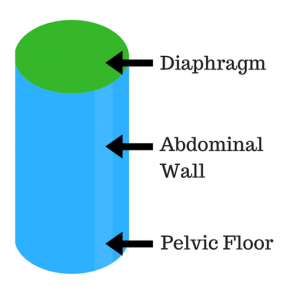Over weeks 2 & 3 of the Introduction Course we have focused on the abdominal muscles and diaphragm working together to create core stability.
This week we are going to focus on the pelvic floor which forms the base of the core muscle cylinder and also assists in core stability and supporting the spine.
What are pelvic floor muscles?
 The pelvic floor is a group of muscles that form the base of your pelvis.
The pelvic floor is a group of muscles that form the base of your pelvis.
They support your internal organs, maintain bladder and bowel control (stopping any leakage when you sneeze, cough and lift heavy objects), support the spine and improve sexual function and sensitivity. It’s actually quite a big ask for 80 plus years of life!
Both men and women have pelvic floor muscles and often we’re not fully aware of these muscles until it lets us down somehow.
How to switch on the pelvic floor
- Lay on your back with knees bent and with a neutral pelvis
- Relax your body by letting go of any tension in your buttocks, thighs, abdominals and jaw. Take a few deep breaths in and out to help relax
- Think about pulling up at the back of the pelvis as if you are trying to stop wind. Now also pull up at the front of the pelvis as if you are trying to stop the flow of urine. Draw these 2 points together and up (Men imagine you are walking through cold water that’s waist height and are ‘lifting up’)
- Slowly release
Try to breathe normally throughout the exercise and relax your pelvic floor between each repetition.
Be careful not to push/bear down or switch on other irrelevant muscles. You may feel a connection in the abdominals and buttocks but they should not consciously be activated. There should be no pelvic tilting.
Homework Exercise
Try to do 3 sets of 10 repetitions every day – or just what you can to start of with.
Once you get the hang of it, try also standing and seated.

